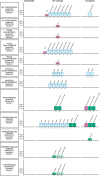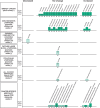An Umbrella Review of Meta-Analyses Evaluating Associations between Human Health and Exposure to Major Classes of Plastic-Associated Chemicals
- PMID: 39183960
- PMCID: PMC11342836
- DOI: 10.5334/aogh.4459
An Umbrella Review of Meta-Analyses Evaluating Associations between Human Health and Exposure to Major Classes of Plastic-Associated Chemicals
Abstract
Background: Epidemiological research investigating the impact of exposure to plastics, and plastic-associated chemicals, on human health is critical, especially given exponentially increasing plastic production. In parallel with increasing production, academic research has also increased exponentially both in terms of the primary literature and ensuing systematic reviews with meta-analysis. However, there are few overviews that capture a broad range of chemical classes to present a state of play regarding impacts on human health. Methods: We undertook an umbrella review to review the systematic reviews with meta-analyses. Given the complex composition of plastic and the large number of identified plastic-associated chemicals, it was not possible to capture all chemicals that may be present in, and migrate from, plastic materials. We therefore focussed on a defined set of key exposures related to plastics. These were microplastics, due to their ubiquity and potential for human exposure, and the polymers that form the matrix of consumer plastics. We also included plasticisers and flame retardants as the two classes of functional additive with the highest concentration ranges in plastic. In addition, we included bisphenols and per- and polyfluoroalkyl substances (PFAS) as two other major plastic-associated chemicals with significant known exposure through food contact materials. Epistemonikos and PubMed were searched for systematic reviews with meta-analyses, meta-analyses, and pooled analyses evaluating the association of plastic polymers, particles (microplastics) or any of the selected groups of high-volume plastic-associated chemicals above, measured directly in human biospecimens, with human health outcomes. Results: Fifty-two systematic reviews were included, with data contributing 759 meta-analyses. Most meta-analyses (78%) were from reviews of moderate methodological quality. Across all the publications retrieved, only a limited number of plastic-associated chemicals within each of the groups searched had been evaluated in relevant meta-analyses, and there were no meta-analyses evaluating polymers, nor microplastics. Synthesised estimates of the effects of plastic-associated chemical exposure were identified for the following health outcome categories in humans: birth, child and adult reproductive, endocrine, child neurodevelopment, nutritional, circulatory, respiratory, skin-related and cancers. Bisphenol A (BPA) is associated with decreased anoclitoral distance in infants, type 2 diabetes (T2D) in adults, insulin resistance in children and adults, polycystic ovary syndrome, obesity and hypertension in children and adults and cardiovascular disease (CVD); other bisphenols have not been evaluated. Phthalates, the only plasticisers identified, are associated with spontaneous pregnancy loss, decreased anogenital distance in boys, insulin resistance in children and adults, with additional associations between certain phthalates and decreased birth weight, T2D in adults, precocious puberty in girls, reduced sperm quality, endometriosis, adverse cognitive development and intelligence quotient (IQ) loss, adverse fine motor and psychomotor development and elevated blood pressure in children and asthma in children and adults. Polychlorinated biphenyls (PCBs), polybrominated diphenyl ethers (PBDEs) but not other flame retardants, and some PFAS were identified and are all associated with decreased birth weight. In general populations, PCBs are associated with T2D in adults and endometriosis, bronchitis in infants, CVD, non-Hodgkin's lymphoma (NHL) and breast cancer. In PCB-poisoned populations, exposure is associated with overall mortality, mortality from hepatic disease (men), CVD (men and women) and several cancers. PBDEs are adversely associated with children's cognitive development and IQ loss. PBDEs and certain PFAS are associated with changes in thyroid function. PFAS exposure is associated with increased body mass index (BMI) and overweight in children, attention deficit hyperactive disorder (ADHD) in girls and allergic rhinitis. Potential protective associations were found, namely abnormal pubertal timing in boys being less common with higher phthalate exposure, increased high-density lipoprotein (HDL) with exposure to mono(2-ethyl-5-oxohexyl) phthalate (MEOHP) and reduced incidence of chronic lymphocytic lymphoma (a subtype of NHL) with PCB exposure. Conclusions: Exposure to plastic-associated chemicals is associated with adverse outcomes across a wide range of human health domains, and every plastic-associated chemical group is associated with at least one adverse health outcome. Large gaps remain for many plastic-associated chemicals. Recommendations: For research, we recommend that efforts are harmonised globally to pool resources and extend beyond the chemicals included in this umbrella review. Priorities for primary research, with ensuing systematic reviews, could include micro- and nanoplastics as well as emerging plastic-associated chemicals of concern such as bisphenol analogues and replacement plasticisers and flame retardants. With respect to chemical regulation, we propose that safety for plastic-associated chemicals in humans cannot be assumed at market entry. We therefore recommend that improved independent, systematic hazard testing for all plastic-associated chemicals is undertaken before market release of products. In addition because of the limitations of laboratory-based testing for predicting harm from plastic in humans, independent and systematic post-market bio-monitoring and epidemiological studies are essential to detect potential unforeseen harms.
Keywords: Evidence synthesis; Human health; Plastic-associated chemicals; Plastics; Umbrella review.
Copyright: © 2024 The Author(s).
Conflict of interest statement
CSy, YM and SD are employed by the Minderoo Foundation. The University of Adelaide received part payment for the conduct of this work by EA, JD, CSt, THB, AW, DP and TM from the Minderoo Foundation. Neither the Minderoo Foundation, nor its benefactors, had any influence over the conduct, the findings, or the recommendations of the work presented in this paper.
Figures












References
Publication types
MeSH terms
Substances
LinkOut - more resources
Full Text Sources

